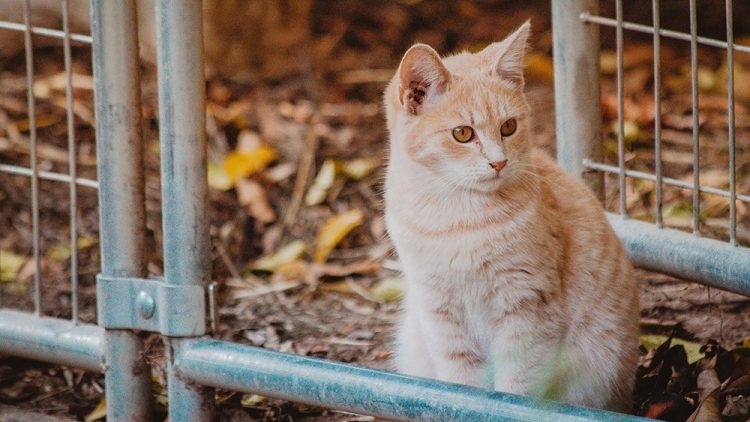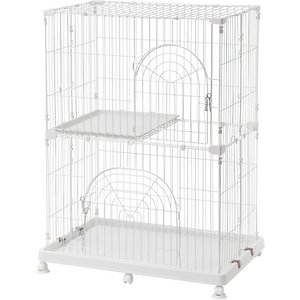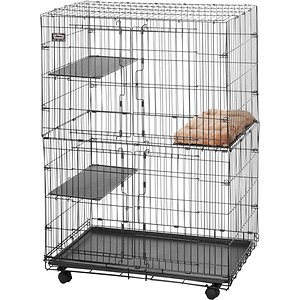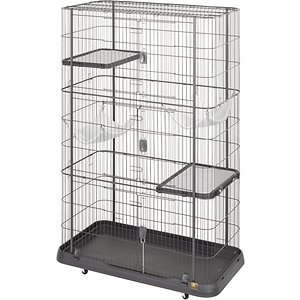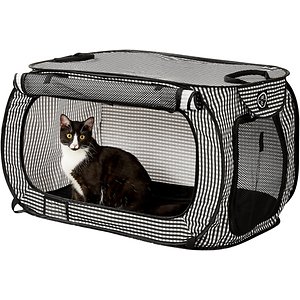These cat cages and playpens are perfect for cat owners who are looking for an enclosure to keep their cat safe and contained during certain periods. We must stress early on that cat playpens are not a permanent home for your cat, and as such should only be used when you have good reason to do so.
On this page:
Of all the cages we’ve tried and tested over the years, the IRIS Multi-Story Wire Cat Play Pen reigns supreme as the best cat cage for indoor use. We’ve put this down to a combination of its build quality and excellent value for money. It’s been around for a good while now and still remains one of the best deals on the market.
Cat cages come in a variety of different sizes, each with a different amount of tiers and perches to the last. We’ve put together the following table to help you see at a glance which might suit your needs best. Stick around for a more in-depth review of each of our favorite cat playpens.
Size Comparison of the Best Cat Cages
| Name | Length | Width | Height |
|---|---|---|---|
| IRIS Multi-Story Wire Cat Play Pen | 36.8" | 24.8" | 47.6" |
| Prevue Premium Cat Cage Home | 43.3" | 25.3" | 65.8" |
| MidWest Collapsible Cat Playpen Cage | 36.0" | 23.5" | 50.5" |
| Necoichi Portable Stress Free Cat Cage | 31.8" | 20.0" | 20.0" |
It’s important to pay close attention to the size of the cages and enclosures featured above. Measure out an area in your home and be sure you have the space to accommodate it before making a buying the enclosure that suits you best.
The Best Cat Cages and Enclosures For Indoor Use
Some of these are pretty tall. Extra height provides more room for your cat to jump around, so it’s often down to a trade-off between space consumed and comfort provided. With that said, here’s a list of the best cat cages for indoor use that will keep your cat safely confined for a temporary period.
1. IRIS Multi-Story Wire Cat Play Pen
This is by far the largest option on our list. It stands at a staggering 70″ in height, and though it only contains 3 tiers, it’s the most spacious cat cage we’ve seen around. We love it, and would say the slightly higher price tag is definitely worth it in terms of appearance and build quality. This thing is built to last.
There’s a real feel of quality to the product that’s only rivaled by the Prevue Pet Deluxe Home. There’s something about the white powder coated bars that make this a bit prettier on the eye too.
It has three doors that are pretty distinguishable in the product photo. Each locks tightly with a pin lock. The wires feel as though they are a considerably thicker gauge than the MidWest Homes cage, but again you do pay that little extra for this pretty white playpen, so it’s to be expected.
Powder white bars and clean light gray trays at each level make this cage a perfect for modern homes. There’s so much room inside that it doesn’t feel right to call it a “cage”, it definitely feels more like a playpen and the white coloring just makes it seem more friendly.
As with others, it’s on wheels (six this time!) and it has coasters that lock it in place so heavy bumps from your cat won’t move it around.
2. MidWest Collapsible Cat Playpen Cage
This cat cage from MidWest Homes for Pets is the perfect balance of quality and price. It’s incredibly modest price tag given the durability is the reason we rate is as one of the best cat crates around.
The stainless steel bars are thick enough to provide a secure enclose for your cat while retaining enough visibility to make them feel comfortable.
It has three adjustable perches that can be moved around or removed completely depending on you (and your cat’s) preference.
All three of the removable tiers are sturdy enough to handle even the heaviest of cats jumping between them.
The bottom tray is leak-proof and removable making for easy cleaning when the crate is not in use and the large swing-open doors make it easy to place or remove any items like litter boxes or toys in without having to undo any awkward hatches.
You get a lot out of the space that this medium sized cat crate offers. Each of the doors (one top, one bottom) open easily with one hand but are impossible to open from the inside, so there’s no risk of a great escape.
It isn’t the easiest cat cage on our list to put together, you’ll need a hand. It’s mostly down to how flat it packs away for storage, you can’t win them all I suppose! Once it’s up, it’s easy to move around thanks to the four strong wheels that support it’s 44lbs of weight easily.
You get a plush cat bed included in your purchase, and if you have need to keep more than one cat at a time or need a replacement you can purchase the beds separately.
It comes with a 1 year manufacturers warranty and the bars are coated with a black E-coat finish that prevents rusting. If we weren’t already sold on this product, the price tag is what seals the deal. It’s a considerable amount cheaper at the time of writing than the other metal cat crates on our list.
3. Prevue Premium Cat Cage Home
If your budget isn’t too tight and you can afford to stretch a little further to buy a high end model, the Prevue Pet Deluxe Home is the choice for you.
It’s much taller than our budget cat cage option, allowing for up to four tiers and hammocks to be attached with plenty of space for your cat to hop between them.
There is a noticeable increase in quality over the MidWest Homes cat crate, but that’s to be expected with the slightly higher price tag.
The “paw friendly” bar design ensures there are no gaps between the crossover points. This eliminates any risk of pinching when your cat applying pressure to one of these points with their paw.
Unlike our top rated cage, this one is super easy to assemble on your own in less than 30 minutes. You get two extra large hammocks that are enough to fit two cats at a time, and two lock-in platforms that you can move around or remove entirely as you see fit.
There’s so much room in this cage that despite it being the more expensive cat cage, we prefer it. The extra level and space to keep food, litter, and toys really does make a difference to the cat’s comfort.
If we could make one recommendation, it’d be that you invest in a high sided litter box. Despite the wide opening doors it can be awkward to pick litter out of the corners, so keep that in mind if you’re using it to litter train a kitten.
You can see plenty of images of cats inside this playpen using the button above. Hopefully it’ll give you a better idea of just how much room they have to move around in.
4. Necoichi Portable Stress Free Cat Cage
Time for something a little different. We think the three cat cages above are your best bet as far as upright enclosures ago, so we thought we’d sneak in this cute little playpen as our fourth pick.
Because of it’s small in size, it’s portability is something the other enclosures can’t compete with. It’s the perfect solution for traveling short-term with cats.
You get a waterproof fleece mat with the enclosure and a carrier bag that’s big enough to carry both the playpen and other Necoichi portable cat items (they’re fantastic).
The wall material is surprisingly thick, meaning there’s no chance of them ripping through it with their claws. Overall it’s an adorable little mesh cage that’s surprisingly practical and very easy on the pocket.
It also has the bonus of being a nice little escape for them in a busy household if left out and open in a quiet space. They’re guaranteed to love having a space of their own.
A Guide To Indoor Cages and Enclosures As A Temporary Space
Why cat cages aren’t a permanent solution?
Cats love their independence; though it hurts to think it, they live with us because it’s a mutually beneficial arrangement. We give them food and shelter, they give us love in return.
Cat cages are not made to imprison cats; they are designed to help during transportation, in taming feral cats and in training.
Temporary caging should not be viewed as a cruel thing to do; it has many advantages that often means it works out best for both you in the long run. Cat lovers have long agreed to the fact that keeping cats indoors can in some cases result in greatly improved quality of life.
Though not true for everyone, keeping your cat indoors can protect them from the stress of territory wars, as well as outside hazards.
We’ve already spoken about them not being a permanent solution, but it also helps to keep in mind that when you do first introduce your cat to a crate or a playpen, they’re likely to withdraw and become suppressed both mentally and physically.
Studies have shown that both domestic and wild cats decrease their exploratory behavior and tend to want to stay in hiding when placed in a strange environment. It may take a while for your cat to get used to being in the crate, but it’s totally normal.
Cats exhibit strange behaviors when uncomfortable. In a cat cage this is often manifested in disrupting their surroundings. Knocking things over, flicking litter around, tearing up toys are all natural responses in the early stages.
As a cat owner you have an ethical obligation to ensure your cat is in a comfortable housing environment. You can relieve anxiety by introducing familiar toys, spending as much time as you can with the cat, touching through the cage, just as you would if you were traveling with them in a cat carrier.
Introducing your cat to it’s new cat cage
It’s well observed by most owners and pet behavior specialists alike, that when animals are placed in strange environment they become stressed.
Some cats will do anything to avoid being put in cage. They may start scratching and pushing away from the cage the moment they see it.
It’s advisable that you start off slow and exercise a lot of patience during the process. Lets look at two proven methods for helping cats use their cat cage that can hopefully help you out a little.
Let the cat decide on its own
When you finally bring the cage home, do not force your cat or kitten to enter it.
Leave the cage open and let your cat explore it at its own convenience and pleasure. Remember that cats are naturally very inquisitive creatures.
There is no need for alarm if the cat initially ignores the cage, leaving the cat to explore the cage on its own terms will make your life much, much easier in the future.
If cat feels that there is no pressure to go inside, after a while you will find your cat being quite agreeable to the idea of entering and staying in the enclosure.
You can also help entice your cat to go into the cage by throwing a toy or treat in there. If the cat wants to leave the cage do not resist, remember patience is key.
Do this repeatedly for some time and eventually the cat will get comfortable with being inside a cage. Finally, when the cat is not in a hurry to jump out you can start gently closing the door and seeing how they react.
Cages can be fun
Sounds like the biggest lie ever, right?
Take some inspiration from other cat furniture, dangle toys from the top bars, hang rope under each tier, anything to make it as entertaining an environment as possible for your cat.
If you cat begins to associate the cage with things other than being locked up, they’ll be much more willing to enter of their own accord.
Many indoor cats are accustomed to using outdoor cat enclosures and cages to spend time outside, so rest assured that despite the initial struggle, it is possible to get them to enjoy it!
Using cat cages for litter training
This is also commonly referred to as crate training. Litter box avoidance is a commonly experienced problem among vets and cat owners.
The key to solving this problem (as with most things with cats) lays in patience. There are a variety of factors that may be affecting your cat’s ability to use its litter box. Unfortunately you might take a while before you fully establish the exact reason why your cat is acting that way.
Do not punish your cat for forgetting how to behave appropriately, the anxiety and confusion will only lead to more erratic behavior. Getting a good cat crate is the first step of the training process. Place the crate in a quiet room or side of your house that has minimum human traffic, but isn’t totally secluded.
The training may take as long a month and it can be quite difficult. A lot of the difficulty comes with trying to get your cat in the cage and managing your frustrations.
When you first put your cat in the cage, provide a tasty meal to help reduce the stressful nature of captivity. For the first two weeks, all toilet time should be carried out within the cage.
Make the experience easier by constantly playing with the cat, you can dangle a ribbon or feather through the wires.
After a while you should let your cat come out of the crate under supervision and stay in the room where the crate is. It is important that you let your cat out for several times during for grooming or to play.
When your cat is comfortable using the litter box outside of the crate you’re all done.
What to look for in an indoor cat cage
Cat cages are not supposed to serve as permanent homes our pet cats, we really can’t stress this enough.
They come in handy when you are not around to supervise your cat or if you are temporarily living in an apartment’s top floors that have balconies.
It is really, really important that you make sure the cage you purchase is sage and of good quality. Here are some selling points you want to keep in mind when buying an indoor cat enclosure.
Versatility
Look for a cage that can be easily folded for convenient storage. This can come in handy to those cat owners who like traveling around with their cats, or for those who will only need the cage periodically.
A good cage should come fitted with casters at the bottom. These casters should be able to roll and lock to make cleaning easier and ensure the crate can’t move around with your cat’s movements.
Space
The best cat cages have ample space for the cat to play and rest in. This will reduce the stressful feeling of being held in a small space.
Cat crates with multiple levels allow for jumping and playing to keep a cat exercised and active.
Sturdy Construction
The enclosure you buy for your cat must be constructed with the highest quality materials. This guarantees longevity of the cage and also ensures the cage does not fall apart when the cat is playing or during an episode of disruption.
Look for cages with bars that don’t allow gaps between crossover points where your cat’s paw could potentially become pinched. Ouch.
Did you find this article helpful?
